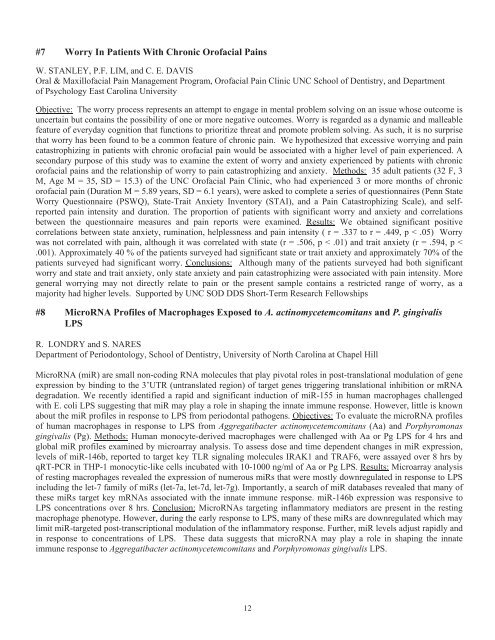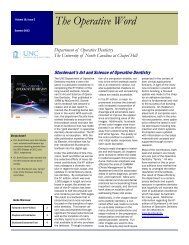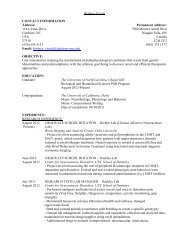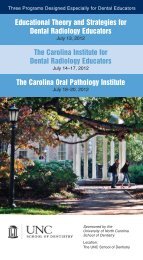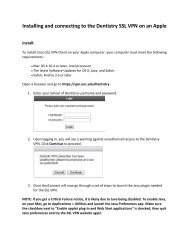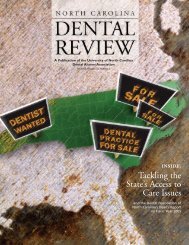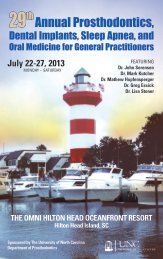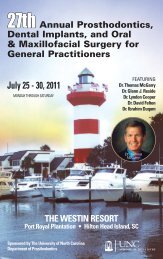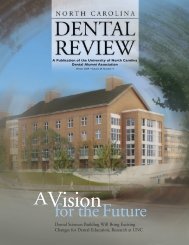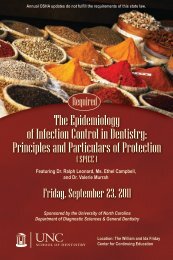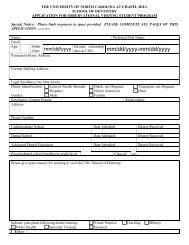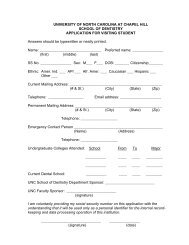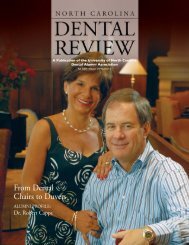UNC School of Dentistry - The University of North Carolina at ...
UNC School of Dentistry - The University of North Carolina at ...
UNC School of Dentistry - The University of North Carolina at ...
You also want an ePaper? Increase the reach of your titles
YUMPU automatically turns print PDFs into web optimized ePapers that Google loves.
#7 Worry In P<strong>at</strong>ients With Chronic Or<strong>of</strong>acial PainsW. STANLEY, P.F. LIM, and C. E. DAVISOral & Maxill<strong>of</strong>acial Pain Management Program, Or<strong>of</strong>acial Pain Clinic <strong>UNC</strong> <strong>School</strong> <strong>of</strong> <strong>Dentistry</strong>, and Department<strong>of</strong> Psychology East <strong>Carolina</strong> <strong>University</strong>Objective: <strong>The</strong> worry process represents an <strong>at</strong>tempt to engage in mental problem solving on an issue whose outcome isuncertain but contains the possibility <strong>of</strong> one or more neg<strong>at</strong>ive outcomes. Worry is regarded as a dynamic and malleablefe<strong>at</strong>ure <strong>of</strong> everyday cognition th<strong>at</strong> functions to prioritize thre<strong>at</strong> and promote problem solving. As such, it is no surpriseth<strong>at</strong> worry has been found to be a common fe<strong>at</strong>ure <strong>of</strong> chronic pain. We hypothesized th<strong>at</strong> excessive worrying and painc<strong>at</strong>astrophizing in p<strong>at</strong>ients with chronic or<strong>of</strong>acial pain would be associ<strong>at</strong>ed with a higher level <strong>of</strong> pain experienced. Asecondary purpose <strong>of</strong> this study was to examine the extent <strong>of</strong> worry and anxiety experienced by p<strong>at</strong>ients with chronicor<strong>of</strong>acial pains and the rel<strong>at</strong>ionship <strong>of</strong> worry to pain c<strong>at</strong>astrophizing and anxiety. Methods: 35 adult p<strong>at</strong>ients (32 F, 3M, Age M = 35, SD = 15.3) <strong>of</strong> the <strong>UNC</strong> Or<strong>of</strong>acial Pain Clinic, who had experienced 3 or more months <strong>of</strong> chronicor<strong>of</strong>acial pain (Dur<strong>at</strong>ion M = 5.89 years, SD = 6.1 years), were asked to complete a series <strong>of</strong> questionnaires (Penn St<strong>at</strong>eWorry Questionnaire (PSWQ), St<strong>at</strong>e-Trait Anxiety Inventory (STAI), and a Pain C<strong>at</strong>astrophizing Scale), and selfreportedpain intensity and dur<strong>at</strong>ion. <strong>The</strong> proportion <strong>of</strong> p<strong>at</strong>ients with significant worry and anxiety and correl<strong>at</strong>ionsbetween the questionnaire measures and pain reports were examined. Results: We obtained significant positivecorrel<strong>at</strong>ions between st<strong>at</strong>e anxiety, rumin<strong>at</strong>ion, helplessness and pain intensity ( r = .337 to r = .449, p < .05) Worrywas not correl<strong>at</strong>ed with pain, although it was correl<strong>at</strong>ed with st<strong>at</strong>e (r = .506, p < .01) and trait anxiety (r = .594, p


